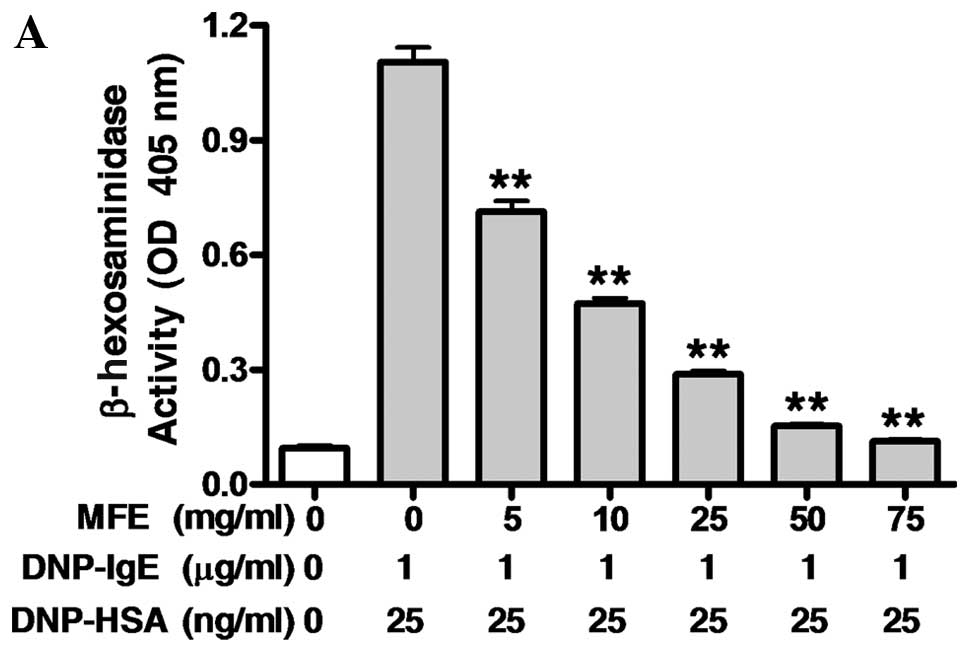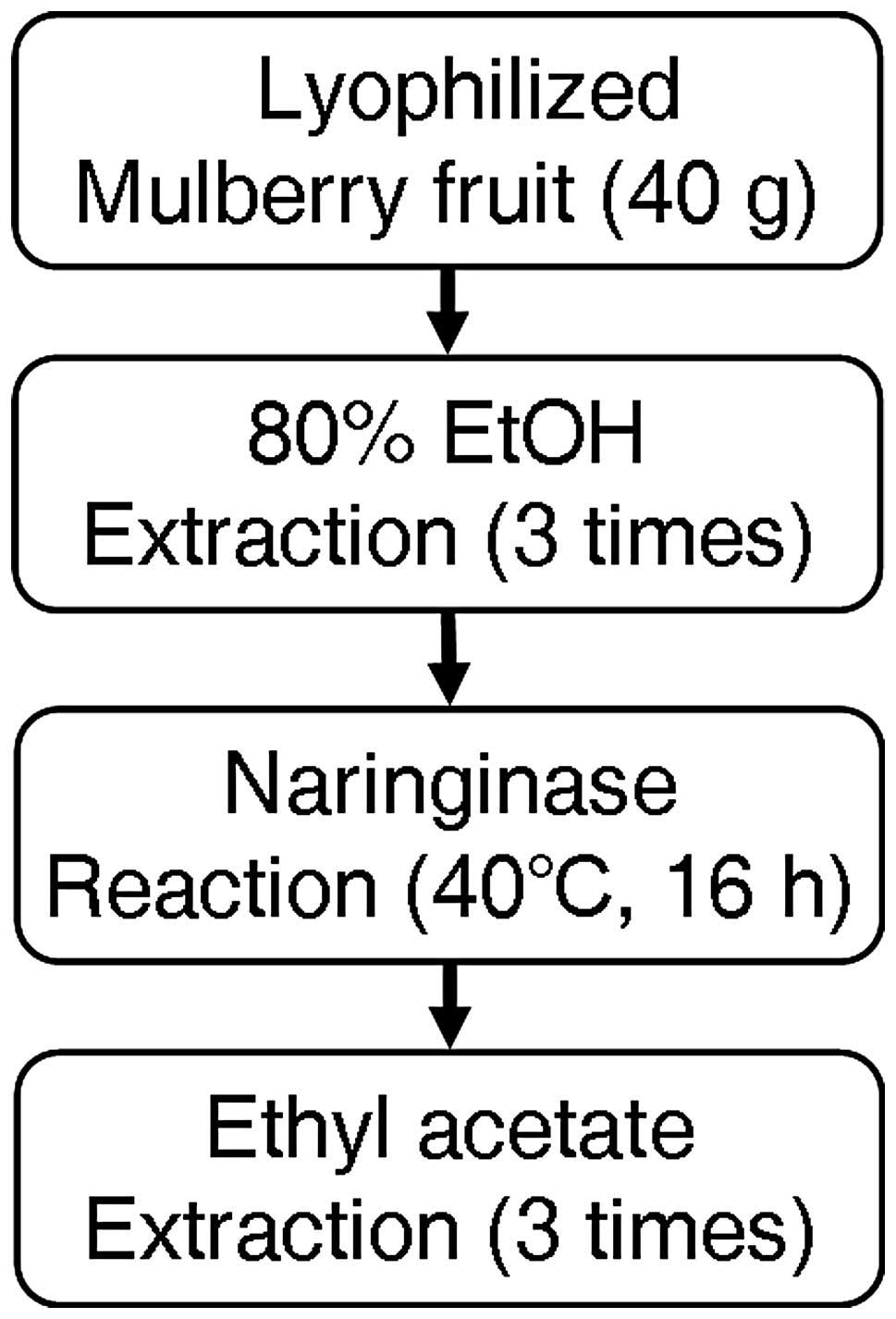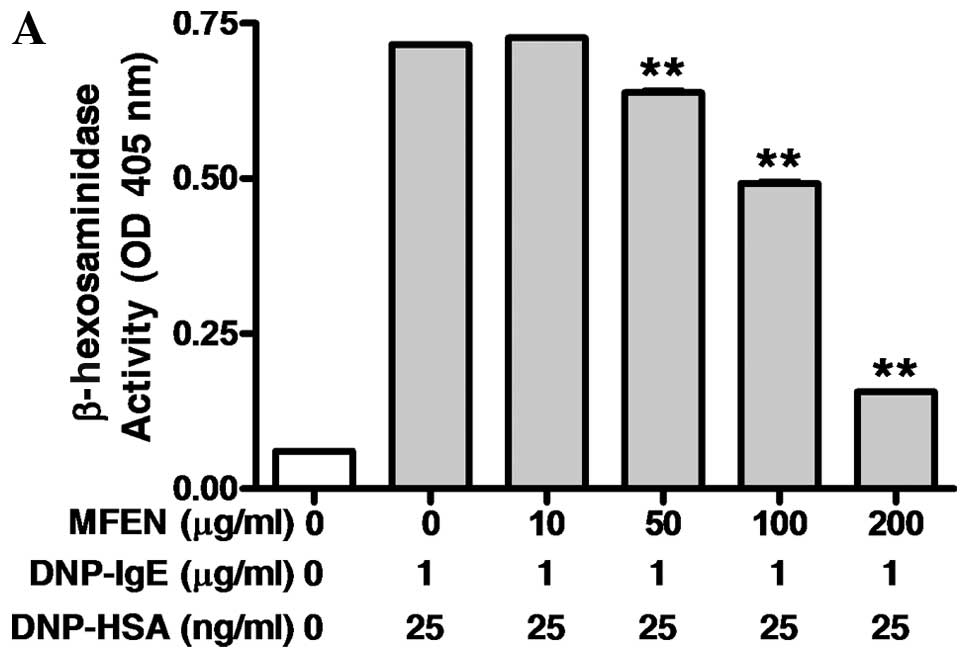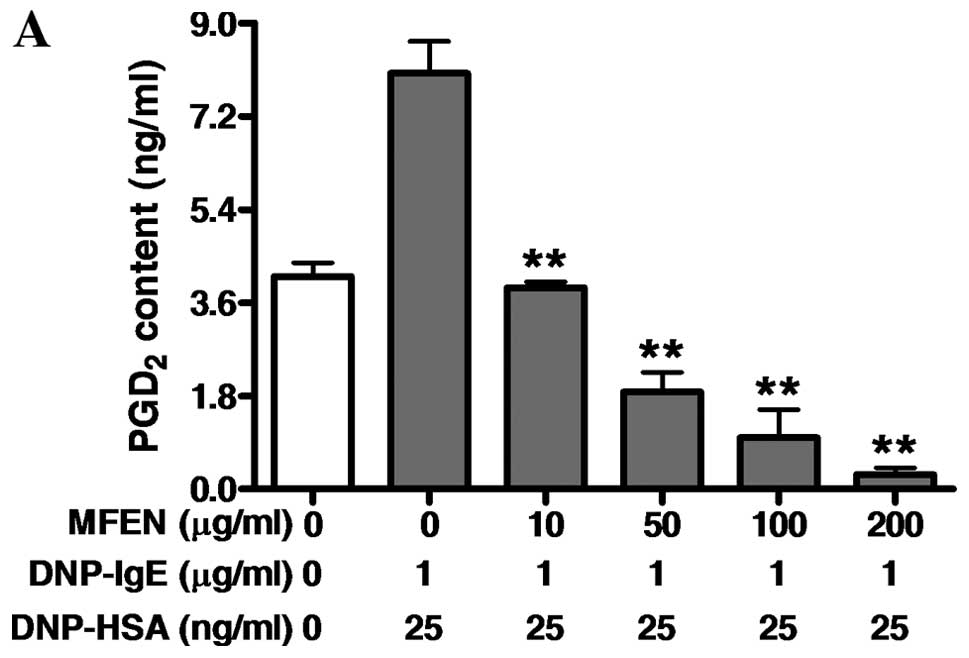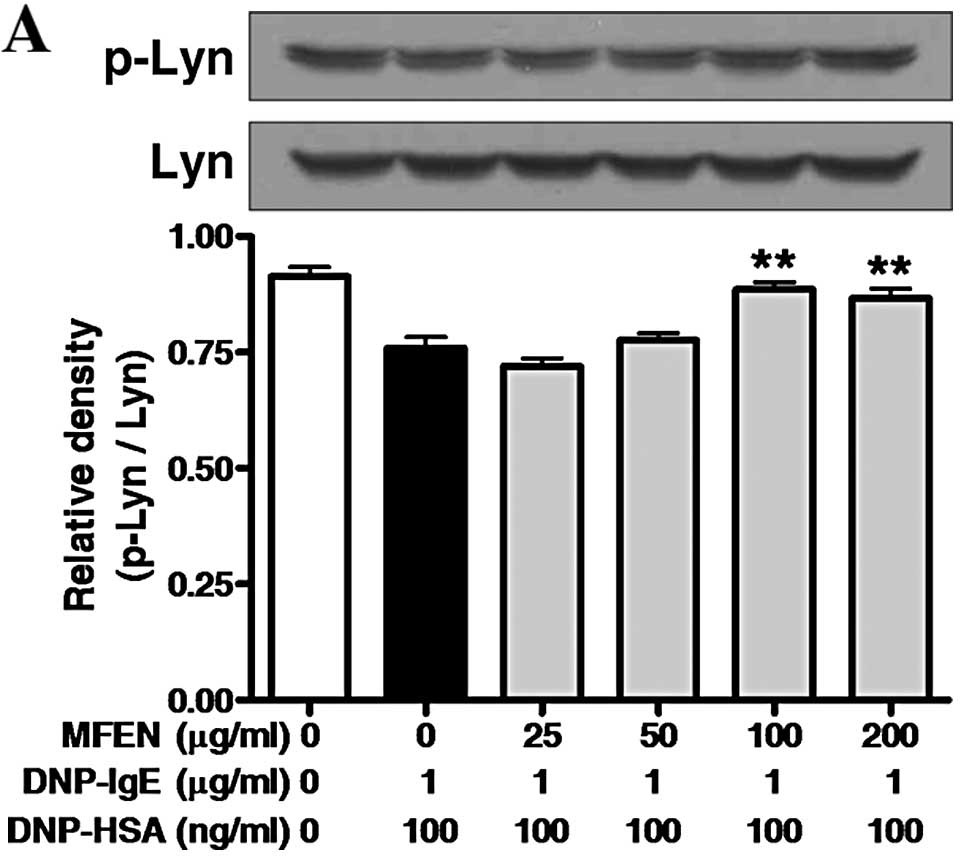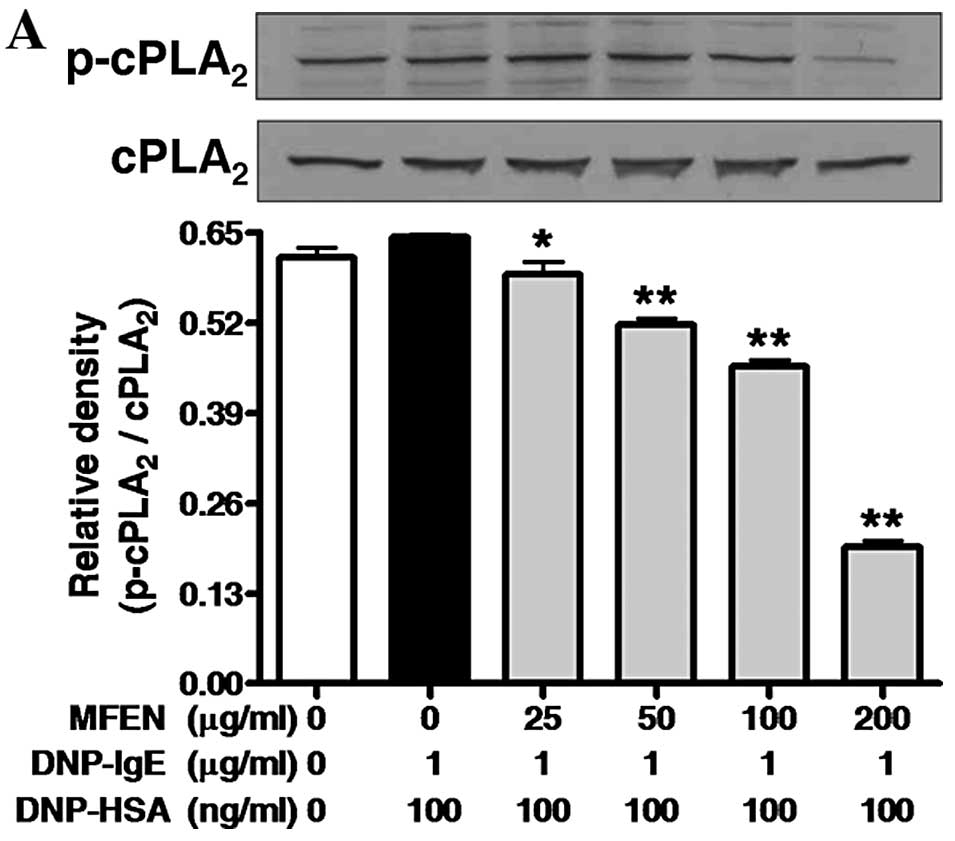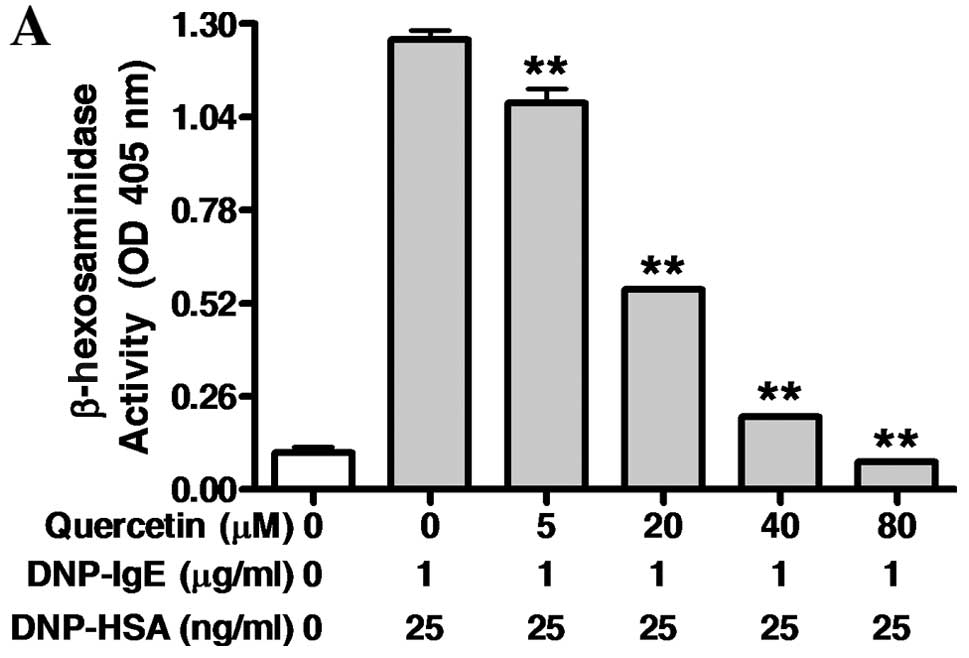Inhibitory effects of mulberry fruit extract in combination with naringinase on the allergic response in IgE-activated RBL-2H3 cells
- Authors:
- Published online on: December 13, 2013 https://doi.org/10.3892/ijmm.2013.1590
- Pages: 469-477
Abstract
Introduction
Mulberry fruit (Morus alba L.) has been reported to be have beneficial effects in biological events, such as oxidative stress (1), hyperlipidemia (1), cancer (2), neurodegeneration (3) and inflammation (4). Such effects are associated with polyphenol compounds, such as cyanidin 3-rutinoside, cyanidin 3-glucoside and rutin in mulberry fruit (2,4–6). Nonetheless, to our knowledge, the inhibitory effects of mulberry fruit on allergic response have not been reported to date.
Naringinase is known as α-rhamnopyranoside, possessing the activities of α-L-rhamnosidase (E.C. 3.2.1.40) and β-D-glucosidase (E.C. 3.2.1.21) (7). Thus, the enzyme is able to hydrolyze naringin to release L-rhamnose and naringenin (8). The enzyme has been isolated from plants, yeast, or microorganisms, such as Aspergillus niger (8), Coniothyrium diplodiella (9), Aspergillus terreus (10) and Penicillium decumbens (11). Moreover, the enzyme can also hydrolyze rutin, isoquercetin, hesperidin, diosmin and ter-phenyl glycosides (7,12). Thus, the enzyme has been widely used in biological engineering processes, such as the debittering of fruit juices, preparation of antibiotics, biotransformation of steroids, production of aglycones, production of ginsenosides and the production of glycolipids (7). Nevertheless, to our knowledge, the biological activity of mulberry fruit in combination with naringinase has not been reported to date.
Mast cells play an important role in the initiation and progression of allergy-related diseases, such as asthma, psoriasis and arthritis (13), and cells expressing FcɛRI receptor on the plasma membrane are also critical cells in the progression of allergic and anaphylactic reactions (14). As the FcɛRI receptor is known to be an immunoglobulin E (IgE) high-affinity receptor, the activation of the FcɛRI receptor can promote the liberation of various inflammatory mediators, including histamine, chemotactic factors, cytokines and arachidonate metabolites from IgE-activated mast cells (15). In this respect, RBL-2H3 cells, belonging to mast cell lines (16), have been commonly used for research on IgE-FcɛRI interactions involving the intracellular signaling cascade and the degranulation and formation of cytokines or eicosanoids (17–19).
Previously, mulberry fruit has been shown to have some beneficial effects in various biological events (1–4), whereas to our knowledge, the inhibitory effects of mulberry fruit on allergic response have not been reported to date. In this respect, we hypothesized that mulberry fruit may exert inhibitory effects on allergic response in IgE-activated mast cells. Thus, in this study, we investigated the anti-allergic action of mulberry fruit extract (MFE) or MFE in combination with naringinase (MFEN) in IgE-activated RBL-2H3 cells, and investigated the mechanisms responsible for the anti-allergic effects of MFEN. The data presented in this study may provide further insight into the therapeutic application of MFEN or its use as a functional food.
Materials and methods
Reagents
Minimal essential medium (MEM), penicillin, streptomycin and fetal bovine serum (FBS) were purchased from Gibco-Life Technologies (Grand Island, NY, USA). 4-[3-(4-Iodophenyl)-2-(4-nitrophenyl)-2H-5-tetrazolio]-1,3-benzene disulfonate (WST-1) was obtained from Dojindo Laboratories (Kumamoto, Japan). Specific antibodies against, Syk, phospho-Syk, Lyn, phospho-Lyn, linker for activation of T cells (LAT), phospho-LAT, extracellular signal-regulated protein kinase 1/2 (ERK1/2), phospho-ERK1/2, JNK, phospho-JNK, GRB2-associated binding protein 2 (Gab2), phospho-Gab2, phosphoinositide-3-kinase (PI3K), phospho-PI3K, Akt, phospho-Akt, phospholipase C (PLC)γ1, phospho-PLCγ1, PLCγ2, phospho-PLCγ2, protein kinase C (PKC)δ, phospho-PKCδ, cytosolic phospholipase A2 (cPLA2), phospho-cPLA2, cyclooxygenase-2 (COX-2) and β-actin were purchased from Cell Signaling Technology, Inc. (Beverly, MA, USA). A specific antibody against phospho-Fyn was obtained from Biorbyt Ltd. (Cambridge, UK). The enzyme-linked immunosorbent assay (ELISA) kit for tumor necrosis factor-α (TNF-α) was obtained from eBioscience, Inc. (San Diego, CA, USA). Specific antibodies against 5-lipoxygenase (5-LO) and phospho-5-LO, as well as enzyme immunoassay (EIA) kits for prostaglandin D2 (PGD2), leukotriene B4 (LTB4) and leukotriene C4 (LTC4) were purchased from Cayman Chemical, Inc. (Ann Arbor, MI, USA). 4-Nitrophenyl N-acetyl-β-D-glucosaminide (p-NAG), dinitrophenyl (DNP)-IgE, DNP- human serum albumin (DNP-HSA) and naringinase were obtained from Sigma-Aldrich (St. Louis, MO, USA). All other chemicals were of analytical grade.
Preparation of MFE
Lyophilized mulberry fruit was obtained from S&D, Inc. (Yeongi, Korea). Lyophilized mulberry fruit (40 g) was extracted with 80% ethanol (1,000 ml) in a bath sonicator for 3 days, and the mixture was filtered by Whatman no. 3 filter paper. The total filtrate was lyophilized, and then the residue of MFE (20 g) was completely dissolved in 0.1 M sodium acetate buffer (pH 4.5) containing 2.5 g naringinase, and then incubated for 18 h at 40°C (20). The solution was added to ethyl acetate (1:1v/v), and then the layer of ethyl acetate was separated and evaporated (evaporator, MG-2100; Buchi, Flawil, Switzerland). The dried residue of ethyl acetate extract (1 g) was dissolved in ethanol or suspended in water.
Analytical methods
High-performance liquid chromatography (HPLC) analysis was carried out as previously described (5,6). To analyze flavonoids, HPLC analysis was performed using a Perkin-Elmer Flexar (Perkin-Elmer, Inc., Waltham, MA, USA) and a Capcell PAK C18 column (4.6×250 mm, 5 μm; Shiseido, Tokyo, Japan). The flavonoids were eluted in gradient system composed of solvent A (methanol:water:acetic acid, 5:92.5:2.5; v/v/v) and solvent B (methanol:water:acetic acid, 95:2.5:2.5; v/v/v). The gradient was 10-50-50-60-10-10% of solvent B at gradient time (tG, 0-12-17-30-30.1-35 min), oven temperature was 40°C and the flow rate was 1.0 ml/min; an injection volume of 10 μl was applied. Perkin-Elmer Flexar UV/Vis detector was set at a wavelength of 280 and 350 nm. The resulting data and chromatographic profiles were evaluated using the Chromera® Chromatography Data System (Perkin-Elmer, Inc.).
To analyze anthocyanins, HPLC analysis was performed using an Agilent Technologies 1200 series (Agilent Technologies, Wilmington, DE, USA) a Synergi 4μ Polar-RP 80A (250×4.6 mm, 4 μm) and a guard column (AQ C18 4×3.0 mm) (both from Phenomenex, Inc., Torrance, CA, USA). The anthocyanins were eluted in gradient system composed of solvent A (water:formic acid, 95:5; v/v) and solvent B (acetonitrile:formic acid, 95:5; v/v). The gradient was 0-10-13-15-15-5-5% of solvent B at gradient time (tG =0-8-15-18-25-25.1-35 min), oven temperature was 40°C and the flow rate was 1.0 ml/min; an injection volume of 10 μl was applied. The UV/Vis detector was set at a wavelength of 520 nm. The resulting data and chromatographic profiles were evaluated using Analyst software (version 1.4.2; Applied Biosystems, Foster City, CA, USA). Separately, to identify flavonoid compounds using the liquid chromatography-electrospray tandem mass spectrometry (LC-ESI/MS/MS), LC-ESI/MS/MS analysis was evaluated following a previously described method (21). The LC-ESI/MS/MS system consisted of an Shimadzu 20AD-XR HPLC system (Shimadzu, Kyoto, Japan) and an API 3200 Q-TRAP LC-MS/MS system equipped with a Turbo V Ion Spray™ source (Applied Biosystems) operated in the negative ion mode. The sample injection volume was 10 μl and the separation was performed on a XTerra™ 3.5μ C18 column (2.1×50 mm i.d.; Waters, Milford, MA, USA) with a SecurityGuard™ C18 guard column (2.0×4.0 mm i.d.; Phenomenex, Inc.). The samples were analyzed via multiple reaction monitoring (MRM). Quantification was performed by MRM of the [M-H]− ion and the related production for quercetin, using an internal standard to establish peak area ratios.
Acquisition and data analysis were performed using Analyst™ software (version 1.5.2; Applied Biosystems). Calibration standards (3.9–1,000 nM) were prepared in blank matrices pre-treated with ice-cold acetonitrile containing 4-methylumbelliferone (internal standard); the pre-treatment of blank matrices was necessary due to the instability of the analytes in the matrices. Calibration curves constructed using linear least-squares regression were linear over the concentration range of the standards used (r2 >0.999). Relative standard deviation (RSD) of the measured concentrations was used to assess the precision. A comparison of the mean measured concentration versus the corresponding nominal concentration was used to assess the accuracy. Both the accuracy (80–120%) and precision (RSD <20%) of the assay were acceptable.
Cell culture
RBL-2H3 cells were cultured in MEM containing 5% (v/v) FBS, 100 U/ml penicillin and 100 μg/ml streptomycin at 37°C in a humidified atmosphere of 5% CO2 as previously described (22).
Cytotoxicity assay
Cell respiration, an indicator of cell viability, was determined by measuring the mitochondrial-dependent reduction of WST-1 to water-soluble tetrazolium salt, as previously described (23). Briefly, the RBL-2H3 cells were seeded on a 96-well plate (1×104 cells/well) in MEM with 5% FBS at 37°C overnight. The cells were washed, and then incubated with DNP-IgE (1 μg/ml) for 24 h. The IgE-sensitized cells were incubated with MFEN at various concentrations (0–200 μg/ml) for 1 h. Both DNP-HSA (25 ng/ml) and WST-1 reagent (10 μl) were simultaneously added to the above, and the mixture was incubated for a further 4 h. To measure cell viability, the absorbance was measured at 450 nm using a microplate reader (Emax; Molecular Devices Inc., Sunnyvale, CA, USA).
β-hexosaminidase release activity
The RBL-2H3 cells were incubated in a 24-well plate (1×105 cells/well) at 37°C overnight. The above cells were washed with 1× PBS, and then incubated with DNP-IgE for 24 h. IgE-sensitized cells were incubated with MFEN (0–200 μg/ml) for 1 h, spiked with DNP-HSA, and then incubated for a further 4 h. To measure the amount of β-hexosaminidase activity released from the cells, the culture medium was transferred and centrifuged (17,000 × g for 10 min) at 4°C. The supernatant (25 μl) was mixed with 50 μl p-NAG (10 mM) in 0.1 M sodium citrate buffer (pH 4.5) into a 96-well plate, and then incubated for 1 h at 37°C. The reaction was terminated by stop buffer (0.1 M Na2CO3 buffer, pH 10.0). The β-hexosaminidase activity was determined by measuring the difference in absorbance at 405 nm.
ELISA of TNF-α
To measure the TNF-α level in the culture medium, all culture media were centrifuged (17,000 × g for 10 min) at 4°C, and the samples were stored at −80°C until use. The concentration of TNF-α was determined using ELISA kits (eBioscience, Inc.) according to the manufacturer’s instructions.
EIA of PGD2, LTB4 and LTC4
To determine the levels of PGD2, LTB4 and LTC4 in the culture medium, all culture media were centrifuged (17,000 × g for 10 min) at 4°C, and the supernatant was stored at −80°C until use. The concentrations of PGD2, LTB4 and LTC4 were determined using EIA kits (Cayman Chemical, Inc.) according to the manufacturer’s instructions.
Immunoblot analysis
Immunoblot analysis was carried out according to a previously described method (24). The membranes were then incubated with a 1:1,000 dilution of specific antibodies against phospho-PLCγ1, PLCγ1, phospho-PLCγ2, PLCγ2, phospho-PKCδ, PKCδ, phospho-Fyn, phospho-Lyn, Lyn, phospho-Syk, Syk, phospho-LAT, LAT, phospho-ERK1/2, ERK1/2, phospho-JNK, JNK, phospho-Gab2, phospho-PI3K, PI3K, phospho-Akt, Akt, phospho-cPLA2, cPLA2, COX-2 and β-actin (Cell Signaling Technology, Inc.), and antibodies against phospho-5-LO and 5-LO (Cayman Chemical, Inc.). The blots were washed with TBS-T, and then incubated with a 1:5,000 dilution of horseradish peroxidase-conjugated IgG secondary antibody (Cell Signaling Technology, Inc.). The proteins on the membranes were detected using a chemiluminescent reaction (ECL plus kit), followed by the exposure of the membranes to Hyperfilm ECL (both from Amersham Pharmacia Biotech, Buckinghamshire, UK). The levels of the target proteins were compared to those of a loading control (β-actin or non-phosphorylated protein), and then the density of the resolved bands was evaluated using ImageJ software.
Statistical analysis
The experimental results are expressed as the means ± SD. One-way analysis of variance (ANOVA) was used for multiple comparisons (GraphPad Prism version 4.03 for Windows; GraphPad Software, San Diego, CA, USA). If there was a significant variation between the treatment groups, the Dunnett test was applied. Values of P<0.05 and P<0.01 were considered to indicate statistically significant differences.
Results
Inhibitory effects of MFE or MFEN on IgE-mediated allergic response in RBL-2H3 cells
First, to determine the effects of MFE on IgE-antigen complex reaction, the IgE-sensitized RBL-2H3 cells were exposed to MFE at various concentrations (0–75 mg/ml) for 1 h, and then stimulated with 25 ng/ml of DNP-HSA for 4 h. MFE markedly inhibited the release of both β-hexosaminidase (IC50, 10.59 mg/ml), a general biomarker of degranulation, and TNF-α (IC50, 4.87 mg/ml), a pro-inflammatory cytokine (Fig. 2). When the IgE-sensitized RBL-2H3 cells were exposed to MFEN, MFE in combination with naringinase (Fig. 1) at various concentrations (0–200 μg/ml) for 1 h prior to antigen challenge, (Fig. 3A and B), MFEN markedly suppressed the release of both β-hexosaminidase (IC50, 123.10 μg/ml) and TNF-α (IC50, 65.01 μg/ml). Moreover, MFEN had no significant cytotoxicity at the concentrations used to inhibit degranulation (Fig. 3C). Taken together, these results indicate that MFE possesses anti-allergic activity, and that the anti-allergic activity of MFE may be derived from certain bioactive components, such as cyanidin 3-rutinoside, cyanidin 3-glucoside or rutin. In addition, treatment with naringinase enhanced the inhibitory effects on allergic response in IgE-activated mast cells. These effects of MFEN may be associated with aglycones, which are released from glycosides.
Inhibitory effects of MFEN on the formation of pro-inflammatory lipid mediators
We then examined the effects of MFEN on the formation of pro-inflammatory lipid mediators, such as PGD2, LTB4 and LTC4 associated with allergic response (16,25–28), since the activation of the arachidonate cascade is involved in FcɛRI activation in IgE-activated mast cells (29). RBL-2H3 cells were pre-incubated with MFEN (0–200 μg/ml) prior to antigen challenge, and the formation of PGD2, LTB4 or LTC4 was then assessed. MFEN markedly inhibited the formation of both PGD2 (IC50, 6.47 μg/ml) and LTC4 (IC50, 0.31 μg/ml), whereas it only slightly suppressed the formation of LTB4 (IC50, 25.75 μg/ml) (Fig. 4). Taken together, these results suggest that MFEN suppresses allergic inflammation induced by PGD2, LTC4 or LTB4. Thus, this indicates that MFEN directly inhibits an enzyme involved in the biosynthesis of prostaglandins or leukotrienes. In particular, our results indicate that MFEN potently inhibits the formation of LTC4, and MFEN may contain a specific inhibitor against LTC4 synthase.
Regulatory effects of MFEN on the FcɛRI signaling pathway
We then investigated the mechanisms responsible for the anti-allergic effects of MFEN. The activation of the FcɛRI receptor is known to be associated with the phosphorylation of Lyn and Syk, which mediate the induction of degranulation in mast cells (27). Quercetin, an aglycone of isoquercetin or rutin, is known to inhibit the degranulation of IgE-activated RBL-2H3 cells (30). Thus, we hypothesized that MFEN can affect the phosphorylation of Lyn or Syk, as well as the FcɛRI cascade. When the IgE-sensitized RBL-2H3 cells were pre-incubated with MFEN (0–200 μg/ml) for 1 h prior to antigen challenge, and then the incubation was extended for a further 10 min, MFEN markedly inhibited Syk phosphorylation, but not that of Lyn or Fyn (Fig. 5A). MFEN dose-dependently suppressed the activation of PLCγ1/2 and PKCδ, implicated in the degranulation process in mast cells (28) (Fig. 5B). Additionally, MFEN reduced the phosphorylation of Gab2, PI3K, Akt, LAT, ERK1/2 and JNK (Fig. 5C and D). These findings indicate that MFEN may directly block the activation of Syk. Consequently, MFEN also inhibited the activation of other targets, such as PLCγ1/2, PKCδ, Gab2, PI3K, Akt, LAT, ERK1/2 and JNK on the FcɛRI cascade in IgE-activated mast cells.
Regulatory effects of MFEN on the enzymes associated with the arachidonate cascade
We additionally investigated the anti-allergic effects of MFEN on the activation of enzymes associated with the arachidonate cascade. The activation of the arachidonate cascade has been implicated in the activation of the FcɛRI receptor in IgE-activated mast cells (27). In this respect, we hypothesized that MFEN, which showed anti-allergic effects, would affect the activation of cPLA2, 5-LO or COX-2. When the IgE-sensitized RBL-2H3 cells were exposed to MFEN at various concentrations for 1 h prior to stimulation with the antigen, and then the incubation was extended for a further 4 h, MFEN suppressed the phosphorylation of cPLA2 and 5-LO, as well as the expression of COX-2 (Fig. 6). These findings indicate that MFEN suppresses the activation of cPLA2, 5-LO and COX-2. In particular, since MFEN at 50 μg/ml strongly inhibited the activation of 5-LO, the composition of MFEN may include a specific inhibitor against 5-LO.
Inhibitory effects of quercetin on IgE-mediated allergic response and flavonoid profiles of MFEN
Finally, to substantiate that MFEN includes quercetin, we analyzed the chemical profiles for anthocyanins and quercetin or its glycosides, such as isoquercetin and rutin using HPLC and LC-ESI/MS/MS. MFE contained cyanidin 3-glucoside, cyanidin 3-rutinoside, isoquercetin and rutin, but not quercetin (Table I). On the other hand, MFEN showed an increase in the amount of quercetin, and all the amounts of glycoside compounds, including isoquercetin and rutin were reduced by treatment with naringinase. In addition, to confirm the anti-allergic effects of quercetin, found in high quantities in MFEN, we examined the IgE-sensitized RBL-2H3 cells exposed to quercetin at various concentrations (0–80 μM) for 1 h, and then stimulated with 25 ng/ml of DNP-HSA for 4 h. Quercetin markedly inhibited the release of both β-hexosaminidase (IC50, 17.58 μM) and TNF-α (IC50, 4.80 μM) (Fig. 7). Taken together, these results indicate that MFEN contains a high level of quercetin, whereas the glycoside compounds in MFEN are reduced by naringinase. Consequently, the anti-allergic effects of MFEN may be derived from quercetin.
Discussion
Previously, mulberry fruit has been reported to possess some biological properties, such as antioxidant (1), anti-hyperlipidemic (1), anti-cancer (2), anti-neurodegenerative (3) and anti-inflammatory properties (4). Mulberry fruit is also known to be rich in polyphenolic compounds, such as cyanidin 3-rutinoside, cyanidin 3-glucoside and rutin, associated with such beneficial effects (2,4–6). Nevertheless, to our knowledge, the inhibitory effects of mulberry fruit on allergic response have not been reported to date.
Separately, naringinase is known to possess the activities of α-L-rhamnosidase (EC 3.2.1.40) and β-D-glucosidase (EC 3.2.1.21) (7). Thus, the enzyme can also hydrolyze cyanidin 3-glucoside, cyanidin 3-rutinoside, isoquercetin or rutin, which found in rich quantities in mulberry fruit, to aglycones with glucose or rutinose (7,12). In support of this, MFE contains cyanidin 3-glucoside, cyanidin 3-rutinoside, isoquercetin and rutin, but not quercetin. In our study, when MFE was incubated with naringinase, the amount of quercetin in MFEN was highly elevated, whereas the amount of isoquercetin or rutin was not detected. Moreover, the anti-allergic effects of MFEN were more potent than those of MFE. In this respect, cyanidin or quercetin, released from cyanidin 3-glucoside or cyanidin 3-rutinoside, isoquercetin or rutin, respectively, may be core chemicals with anti-allergic properties. Although mulberry fruit has been known to contain richer quantities of cyanidin 3-glucoside or cyanidin 3-rutinoside than isoquercetin or rutin (5), cyanidin or cyanidin 3-glucoside have been known to poorly inhibit allergic response in IgE-activated mast cells (31). In addition, in our study, cyanidin 3-glucoside did not inhibit degranulation and TNF-α release in IgE-activated RBL-2H3 cells (data not shown). Quercetin is known to exert a more potent inhibitory effect than cyanidin on allergic response in IgE-activated mast cells (30). In support of this, in our study, MFEN and quercetin inhibited degranulation and TNF-α release in IgE-activated RBL-2H3 cells. Furthermore, the combination of naringinase and mulberry fruit enhanced the anti-allergic activity. This may also enhance other beneficial effects, and such effects may be derived from quercetin.
Concerning the mechanism responsible for the anti-allergic activity of MFEN, one possible mechanism may involve the direct inhibition of the FcɛRI cascade. The IgE-induced degranulation in mast cells is related to the activation of the FcɛRI receptor, and this activation induces the release of various inflammatory mediators containing TNF-α, leukotrienes and prostaglandins through the phosphorylation of the Lyn or Fyn/Syk pathway (28,32). Consequently, the activation of Syk leads to the increase in intracellular Ca2+ levels and the activation of the MAP kinase family (28). Thus, Lyn, Fyn and Syk are important intracellular mediators in the early signaling pathway of FcɛRI receptor activation. In the present study, the inhibition of Syk by MFEN may support the notion that a primary target of MFEN may be Syk. In support of this, MFEN significantly reduced the phosphorylation of Gab2, PI3K, Akt, LAT, ERK1/2 and JNK, which belongs to a downstream protein in the FcɛRI receptor cascade (28). In addition, MFEN suppressed the activation of PLCγ1/2 and PKCδ, which are involved in the process of IgE-mediated degranulation in mast cells (33).
Although MFEN did not completely suppress both cPLA2 phosphorylation and COX-2 expression, it markedly reduced the levels of PGD2, corresponding to the COX-2 product. Thus, these findings suggest that MFEN directly inhibits COX-2 activity or PGD2 synthase in prostaglandin biosynthesis. MFEN at 50 μg/ml completely inhibited the phosphorylation of 5-LO, whereas MFEN had more potent inhibitory effects on the formation of LTB4 and LTC4, corresponding to the 5-LO product, than 5-LO activation. Thus, these findings suggest that MFEN directly inhibits 5-LO activation, as well as LTB4 hydrolase or LTC4 synthase. Therefore, the inhibitory effects of MFEN on the formation of PGD2, LTB4 and LTC4 may be involved in its anti-allergic action. PGD2 is known to cause bronchoconstriction, vasodilation, increase capillary permeability and mucous production in asthma (25). LTB4 is a potent chemoattractant and activator of neutrophils and other immune cells in severe asthma (34,35); LTC4 is known to be a potent spasmogenic and chemotactic biochemical and an agonist of cysteinyl-LT receptors, which is known to induce chronic inflammatory reactions in allergic diseases (26). Taken together, our results suggested that MFEN inhibited allergic reaction through the suppression of Syk, PLCγ1/2, PKCδ, Gab2, PI3K, Akt, LAT, ERK1/2 and JNK, as well as the activation of cPLA2, 5-LO and COX-2. Furthermore, such an effect of MFEN may be extended to its anti-inflammatory effects on other cells or tissues. Several cytokines may play critical roles in allergic inflammation (13). In particular, TNF-α, secreted from mast cells in IgE-antigen complex reaction (36), is known to play an important role in allergic reaction (13). Moreover, the expression of TNF-α is related to the JNK or ERK1/2 activation of the FcɛRI cascade in IgE-activated mast cells (28,33). In the present study, MFEN markedly inhibited the activation ERK1/2 and JNK, and reduced the TNF-α level. Therefore, the reduction of TNF-α formation by MFEN may provide an additional advantage of MFEN as an anti-allergic food.
In conclusion, the present study demonstrates that MFEN possesses anti-allergic functions in IgE-activated RBL-2H3 cells. These findings reveal a novel feature of MFEN in allergic response. The mechanisms responsible for its anti-allergic effects may involve multiple targets, including Syk, PLCγ1/2, PKCδ, Gab2, PI3K, Akt, LAT, ERK1/2, JNK, cPLA2, 5-LO and COX-2. Such effects may be derived from the presence of quercetin, which is released from isoquercetin or rutin by naringinase, and provide further insight into the application of MFEN as a therapeutic reagent or a functional food.
Acknowledgements
This study was financially supported by the Basic Science Research Program through the National Research Foundation of Korea (NRF) funded by the Ministry of Education, Science and Technology (2011-0013606).
References
|
Yang X, Yang L and Zheng H: Hypolipidemic and antioxidant effects of mulberry (Morus alba L.) fruit in hyperlipidaemia rats. Food Chem Toxicol. 48:2374–2379. 2010. View Article : Google Scholar : PubMed/NCBI | |
|
Chen PN, Chu SC, Chiou HL, Kuo WH, Chiang CL and Hsieh YS: Mulberry anthocyanins, cyanidin 3-rutinoside and cyanidin 3-glucoside, exhibited an inhibitory effect on the migration and invasion of a human lung cancer cell line. Cancer Lett. 235:248–259. 2006. View Article : Google Scholar : PubMed/NCBI | |
|
Kim HG, Ju MS, Shim JS, et al: Mulberry fruit protects dopaminergic neurons in toxin-induced Parkinson’s disease models. Br J Nutr. 104:8–16. 2010.PubMed/NCBI | |
|
Liu LK, Lee HJ, Shih YW, Chyau CC and Wang CJ: Mulberry anthocyanin extracts inhibit LDL oxidation and macrophage-derived foam cell formation induced by oxidative LDL. J Food Sci. 73:H113–H121. 2008. View Article : Google Scholar : PubMed/NCBI | |
|
Pawlowska AM, Oleszek W and Braca A: Quali-quantitative analyses of Flavonoids of Morus nigra L. and Morus alba L. (Moraceae) fruits. J Agric Food Chem. 56:3377–3380. 2008. View Article : Google Scholar : PubMed/NCBI | |
|
Song W, Wang HJ, Bucheli P, Zhang PF, Wei DZ and Lu YH: Phytochemical profiles of different mulberry (Morus sp) species from China. J Agric Food Chem. 57:9133–9140. 2009. View Article : Google Scholar : PubMed/NCBI | |
|
Ribeiro MH: Naringinases: occurrence, characteristics, and applications. Appl Microbiol Biotechnol. 90:1883–1895. 2011. View Article : Google Scholar | |
|
Bram B and Solomons GL: Production of the enzyme naringinase by Aspergillus niger. Appl Microbiol. 13:842–845. 1965.PubMed/NCBI | |
|
Nomura D: Studies on naringinase produced by Coniothyrium diplodiella. I The properties of naringinase and the removal of co-existing pectinase from the enzyme preparation. Enzymologia. 29:272–282. 1965.PubMed/NCBI | |
|
Soria F, Ellenrieder G, Grasselli M, Navarro del Cañizo AA and Cascone O: Fractionation of the naringinase complex from Aspergillus terreus by dye affinity chromatography. Biotechnol Lett. 26:1265–1268. 2004. View Article : Google Scholar : PubMed/NCBI | |
|
Magario I, Vielhauer O, Neumann A, Hausmann R and Syldatk C: Kinetic analysis and modeling of the liquid-liquid conversion of emulsified di-rhamnolipids by Naringinase from Penicillium decumbens. Biotechnol Bioeng. 102:9–19. 2009. View Article : Google Scholar : PubMed/NCBI | |
|
Vila-Real H, Alfaia AJ, Bronze MR, Calado AR and Ribeiro MH: Enzymatic synthesis of the flavone glucosides, prunin and isoquercetin, and the aglycones, naringenin and quercetin, with selective alpha-L-rhamnosidase and beta-D-glucosidase activities of naringinase. Enzyme Res. 2011:6926182011. View Article : Google Scholar | |
|
Theoharides TC and Kalogeromitros D: The critical role of mast cells in allergy and inflammation. Ann NY Acad Sci. 1088:78–99. 2006. View Article : Google Scholar : PubMed/NCBI | |
|
Theoharides TC, Alysandratos KD, Angelidou A, et al: Mast cells and inflammation. Biochim Biophys Acta. 1822:21–33. 2012. View Article : Google Scholar : PubMed/NCBI | |
|
Gilfillan AM and Tkaczyk C: Integrated signalling pathways for mast-cell activation. Nat Rev Immunol. 6:218–230. 2006. View Article : Google Scholar : PubMed/NCBI | |
|
Siraganian RP, McGivney A, Barsumian EL, Crews FT, Hirata F and Axelrod J: Variants of the rat basophilic leukemia cell line for the study of histamine release. Fed Proc. 41:30–34. 1982.PubMed/NCBI | |
|
Ortega E, Schweitzer-Stenner R and Pecht I: Possible orientational constraints determine secretory signals induced by aggregation of IgE receptors on mast cells. EMBO J. 7:4101–4109. 1988.PubMed/NCBI | |
|
Funaba M, Ikeda T and Abe M: Degranulation in RBL-2H3 cells: regulation by calmodulin pathway. Cell Biol Int. 27:879–885. 2003. View Article : Google Scholar : PubMed/NCBI | |
|
Ikawati Z, Wahyuono S and Maeyama K: Screening of several Indonesian medicinal plants for their inhibitory effect on histamine release from RBL-2H3 cells. J Ethnopharmacol. 75:249–256. 2001. View Article : Google Scholar : PubMed/NCBI | |
|
Ni H, Chen F, Cai H, Xiao A, You Q and Lu Y: Characterization and preparation of Aspergillus niger naringinase for debittering citrus juice. J Food Sci. 77:C1–C7. 2012. | |
|
Lee SY, Lee JY, Kang W, et al: Cytochrome P450-mediated herb-drug interaction potential of Galgeun-tang. Food Chem Toxicol. 51:343–349. 2013. View Article : Google Scholar : PubMed/NCBI | |
|
Morita Y and Siraganian RP: Inhibition of IgE-mediated histamine release from rat basophilic leukemia cells and rat mast cells by inhibitors of transmethylation. J Immunol. 127:1339–1344. 1981.PubMed/NCBI | |
|
Ishiyama M, Tominaga H, Shiga M, Sasamoto K, Ohkura Y and Ueno K: A combined assay of cell viability and in vitro cytotoxicity with a highly water-soluble tetrazolium salt, neutral red and crystal violet. Biol Pharm Bull. 19:1518–1520. 1996. View Article : Google Scholar : PubMed/NCBI | |
|
Yoo JM, Park ES, Kim MR and Sok DE: Inhibitory effect of N-Acyl dopamines on IgE-mediated allergic response in RBL-2H3 cells. Lipids. 48:383–393. 2013. View Article : Google Scholar : PubMed/NCBI | |
|
Arima M and Fukuda T: Prostaglandin D2 and T(H)2 inflammation in the pathogenesis of bronchial asthma. Korean J Intern Med. 26:8–18. 2011. | |
|
Nettis E, D’Erasmo M, Di Leo E, et al: The employment of leukotriene antagonists in cutaneous diseases belonging to allergological field. Mediators Inflamm. 2010:6281712010. View Article : Google Scholar : PubMed/NCBI | |
|
Kawakami Y, Kitaura J, Satterthwaite AB, et al: Redundant and opposing functions of two tyrosine kinases, Btk and Lyn, in mast cell activation. J Immunol. 165:1210–1219. 2000. View Article : Google Scholar : PubMed/NCBI | |
|
Roth K, Chen WM and Lin TJ: Positive and negative regulatory mechanisms in high-affinity IgE receptor-mediated mast cell activation. Arch Immunol Ther Exp (Warsz). 56:385–399. 2008. View Article : Google Scholar : PubMed/NCBI | |
|
Kim Y, Lee YS, Hahn JH, et al: Hyaluronic acid targets CD44 and inhibits FcepsilonRI signaling involving PKCdelta, Rac1, ROS, and MAPK to exert anti-allergic effect. Mol Immunol. 45:2537–2547. 2008. View Article : Google Scholar : PubMed/NCBI | |
|
Morimoto Y, Yasuhara T, Sugimoto A, et al: Anti-allergic substances contained in the pollen of Cryptomeria japonica possess diverse effects on the degranulation of RBL-2H3 cells. J Pharmacol Sci. 92:291–295. 2003.PubMed/NCBI | |
|
Han SJ, Ryu SN, Trinh HT, et al: Metabolism of cyanidin-3-O-beta-D-glucoside isolated from black colored rice and its antiscratching behavioral effect in mice. J Food Sci. 74:H253–H258. 2009. View Article : Google Scholar : PubMed/NCBI | |
|
Gomez G, Gonzalez-Espinosa C, Odom S, et al: Impaired FcepsilonRI-dependent gene expression and defective eicosanoid and cytokine production as a consequence of Fyn deficiency in mast cells. J Immunol. 175:7602–7610. 2005. View Article : Google Scholar : PubMed/NCBI | |
|
Metcalfe DD: Mast cells and mastocytosis. Blood. 112:946–956. 2008. View Article : Google Scholar : PubMed/NCBI | |
|
Ford-Hutchinson AW, Bray MA, Doig MV, Shipley ME and Smith MJ: Leukotriene B, a potent chemokinetic and aggregating substance released from polymorphonuclear leukocytes. Nature. 286:264–265. 1980. View Article : Google Scholar : PubMed/NCBI | |
|
Tager AM and Luster AD: BLT1 and BLT2: the leukotriene B(4) receptors. Prostaglandins Leukot Essent Fatty Acids. 69:123–134. 2003. View Article : Google Scholar : PubMed/NCBI | |
|
Gordon JR and Galli SJ: Mast cells as a source of both preformed and immunologically inducible TNF-alpha/cachectin. Nature. 346:274–276. 1990.PubMed/NCBI |



